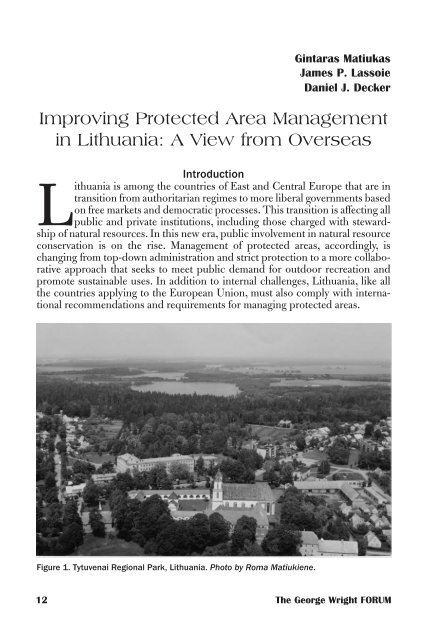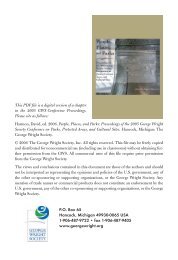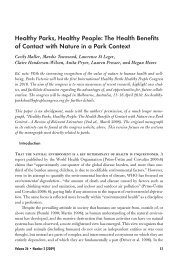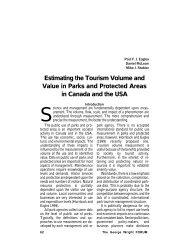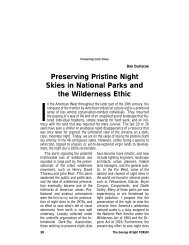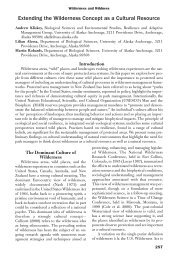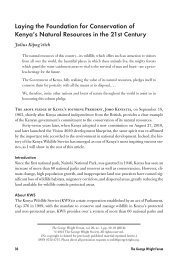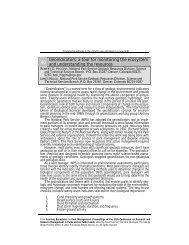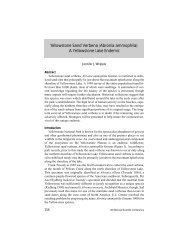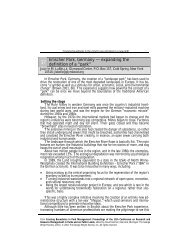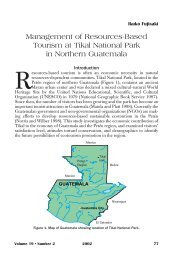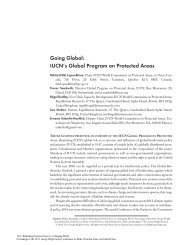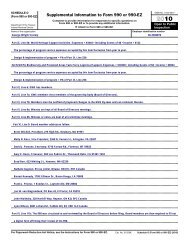Improving Protected Area Management in Lithuania - The George ...
Improving Protected Area Management in Lithuania - The George ...
Improving Protected Area Management in Lithuania - The George ...
You also want an ePaper? Increase the reach of your titles
YUMPU automatically turns print PDFs into web optimized ePapers that Google loves.
G<strong>in</strong>taras Matiukas<br />
James P. Lassoie<br />
Daniel J. Decker<br />
<strong>Improv<strong>in</strong>g</strong> <strong>Protected</strong> <strong>Area</strong> <strong>Management</strong><br />
<strong>in</strong> <strong>Lithuania</strong>: A View from Overseas<br />
Introduction<br />
<strong>Lithuania</strong> is among the countries of East and Central Europe that are <strong>in</strong><br />
transition from authoritarian regimes to more liberal governments based<br />
on free markets and democratic processes. This transition is affect<strong>in</strong>g all<br />
public and private <strong>in</strong>stitutions, <strong>in</strong>clud<strong>in</strong>g those charged with stewardship<br />
of natural resources. In this new era, public <strong>in</strong>volvement <strong>in</strong> natural resource<br />
conservation is on the rise. <strong>Management</strong> of protected areas, accord<strong>in</strong>gly, is<br />
chang<strong>in</strong>g from top-down adm<strong>in</strong>istration and strict protection to a more collaborative<br />
approach that seeks to meet public demand for outdoor recreation and<br />
promote susta<strong>in</strong>able uses. In addition to <strong>in</strong>ternal challenges, <strong>Lithuania</strong>, like all<br />
the countries apply<strong>in</strong>g to the European Union, must also comply with <strong>in</strong>ternational<br />
recommendations and requirements for manag<strong>in</strong>g protected areas.<br />
Figure 1. Tytuvenai Regional Park, <strong>Lithuania</strong>. Photo by Roma Matiukiene.<br />
12<br />
<strong>The</strong> <strong>George</strong> Wright FORUM
<strong>Improv<strong>in</strong>g</strong> <strong>Protected</strong> <strong>Area</strong> <strong>Management</strong> <strong>in</strong> <strong>Lithuania</strong><br />
<strong>The</strong> system of nature protection<br />
areas and their management is still<br />
evolv<strong>in</strong>g <strong>in</strong> <strong>Lithuania</strong>. Challenges<br />
<strong>in</strong>clude a lack of a clear strategy, political<br />
and personal <strong>in</strong>fluence on managers’<br />
activities and priorities, low participation<br />
by local communities, lack<br />
of research and monitor<strong>in</strong>g data, and<br />
<strong>in</strong>sufficient management capacity.<br />
Many of these problems have been<br />
addressed satisfactorily by other countries.<br />
Exam<strong>in</strong><strong>in</strong>g models used successfully<br />
elsewhere can help identify costeffective<br />
approaches for <strong>Lithuania</strong>.<br />
This article recommends ways to<br />
improve protected area management<br />
<strong>in</strong> <strong>Lithuania</strong>, based on the experience<br />
of developed Western countries, primarily<br />
the practices used <strong>in</strong> New York<br />
State.<br />
Table 1. <strong>Protected</strong> areas <strong>in</strong> <strong>Lithuania</strong>.<br />
<strong>Protected</strong> <strong>Area</strong>s <strong>in</strong> <strong>Lithuania</strong><br />
After the restoration of <strong>Lithuania</strong>’s<br />
<strong>in</strong>dependence <strong>in</strong> 1990, the reprivatization<br />
of land required a review of<br />
conservation priorities. Regional<br />
parks were created over a very short<br />
period of about two months <strong>in</strong> 1992,<br />
before the law on private land restitution<br />
was adopted. <strong>The</strong> hasty formation<br />
of the park system left many political<br />
and ecological problems to be reconciled<br />
after the system was created,<br />
thus the management of protected<br />
areas began abruptly, without experience.<br />
<strong>Lithuania</strong>’s protected areas are<br />
roughly comparable to four categories<br />
of protected areas described by<br />
IUCN–<strong>The</strong> World Conservation<br />
Union (IUCN 1994b). Six strict<br />
reserves, five national parks, 30<br />
regional parks, and 290 other reserves<br />
represent the country’s most valuable<br />
landscapes and natural ecosystems<br />
and constitute 11.2% of the total area<br />
(Table 1).<br />
Strict reserves exclude development<br />
and management activities.<br />
National parks have mixed regimes:<br />
no or m<strong>in</strong>imal management <strong>in</strong> conservation<br />
zones, management for visitors’<br />
needs <strong>in</strong> recreation zones, and regulated<br />
management <strong>in</strong> forestry or agricultural<br />
zones. Partial nature and culture<br />
reserves protect specific parts of<br />
ecosystems and landscapes. Regional<br />
parks <strong>in</strong>tegrate development and conservation.<br />
Not all the areas are <strong>in</strong>tended to<br />
protect nature. Of the six strict<br />
reserves, two are cultural. Of the five<br />
national parks, one is historical, and of<br />
the 30 regional parks, there is also one<br />
historical park. Other protected areas<br />
Volume 19 • Number 3 2002 13
<strong>Improv<strong>in</strong>g</strong> <strong>Protected</strong> <strong>Area</strong> <strong>Management</strong> <strong>in</strong> <strong>Lithuania</strong><br />
are managed for a variety of natural<br />
features: geological (10), geomorphologic<br />
(46), hydrographical (35), soil<br />
(12), botanical (38), wetlands (27),<br />
theriological (1), ornithological (6),<br />
herpetological (2), ichthyological (11),<br />
entomological (20), botanical–zoological<br />
(20), landscape (61), cartographical<br />
(1), and cultural (10).<br />
<strong>Lithuania</strong>’s regional parks are<br />
equivalent to protected landscapes<br />
(IUCN category V; IUCN 1994b).<br />
Such areas encourage susta<strong>in</strong>able<br />
development and support traditional<br />
land uses and promote the well-be<strong>in</strong>g<br />
of local communities. <strong>The</strong>ir relative<br />
importance <strong>in</strong> Europe is shown by the<br />
numbers: <strong>Protected</strong> landscapes<br />
account for only 15.3% of the world’s<br />
total protected areas but 66.8% of<br />
Europe’s. Many protected areas <strong>in</strong><br />
Europe are small, close to urban or<br />
<strong>in</strong>dustrial areas, and surrounded by<br />
<strong>in</strong>compatible land uses. Susta<strong>in</strong>able<br />
development with<strong>in</strong> and outside the<br />
parks is becom<strong>in</strong>g a significant issue,<br />
and these parks are pilot areas for<br />
implement<strong>in</strong>g and dissem<strong>in</strong>at<strong>in</strong>g susta<strong>in</strong>able<br />
practices <strong>in</strong> the surround<strong>in</strong>g<br />
communities (Gamb<strong>in</strong>o 2000).<br />
Most American state parks are very<br />
small, entirely public, and focused on<br />
recreation. But the Adirondack State<br />
Park <strong>in</strong> New York, with its size, range<br />
of activities, mixed ownership patterns,<br />
<strong>in</strong>hold<strong>in</strong>gs, and side-by-side<br />
conservation and development, presents<br />
management challenges comparable<br />
with those of the parks <strong>in</strong> <strong>Lithuania</strong>.<br />
We use the experience of the<br />
Adirondack State Park and other protected<br />
landscapes <strong>in</strong> developed countries<br />
to formulate recommendations<br />
for improv<strong>in</strong>g protected area management<br />
<strong>in</strong> <strong>Lithuania</strong> <strong>in</strong> six doma<strong>in</strong>s:<br />
adm<strong>in</strong>istration, management, advisory<br />
boards, work force, stewardship, and<br />
zon<strong>in</strong>g and borders.<br />
Adm<strong>in</strong>istration<br />
Centralization. In most countries,<br />
protected areas are both established<br />
and managed by the central government;<br />
some countries give authority to<br />
regional or local governments (Leitmann<br />
1998), or the adm<strong>in</strong>istration<br />
may be mixed. <strong>The</strong> adm<strong>in</strong>istrative<br />
method depends ma<strong>in</strong>ly on political<br />
and social traditions.<br />
Decentralized management is used<br />
by Austria, Germany, Italy, Spa<strong>in</strong>,<br />
Switzerland, and the United K<strong>in</strong>gdom.<br />
<strong>The</strong> majority of European countries,<br />
like the United States and Canada,<br />
use a mixed model: the central<br />
government establishes and manages<br />
areas of national importance but may<br />
share responsibility for manag<strong>in</strong>g partial<br />
reserves and protected landscapes<br />
with regional and local governments.<br />
<strong>Lithuania</strong> has a very centralized<br />
system: almost all protected areas are<br />
established and managed by the central<br />
government. Because the country<br />
is small and has a long tradition of<br />
strong centralized governance, this<br />
system is acceptable to its citizens.<br />
Collaboration with local authorities<br />
might be strengthened by allow<strong>in</strong>g<br />
local governments to approve the<br />
strategic and management plans of the<br />
protected areas with<strong>in</strong> their jurisdictions.<br />
Consolidated management. Currently,<br />
management of protected areas<br />
<strong>in</strong> <strong>Lithuania</strong> is split: One historical<br />
national park and two cultural strict<br />
reserves are managed by the M<strong>in</strong>istry<br />
of Culture, and two regional parks are<br />
14<br />
<strong>The</strong> <strong>George</strong> Wright FORUM
<strong>Improv<strong>in</strong>g</strong> <strong>Protected</strong> <strong>Area</strong> <strong>Management</strong> <strong>in</strong> <strong>Lithuania</strong><br />
managed by local governments.<br />
In the Adirondacks, divid<strong>in</strong>g management<br />
among separate agencies<br />
complicates the implementation of a<br />
general environmental policy (Meyers<br />
and Green 1989). To improve management<br />
of the Adirondack State Park,<br />
it has been recommended that all state<br />
and private lands be adm<strong>in</strong>istrated<br />
together by the same agency (Commission<br />
on the Adirondacks <strong>in</strong> the<br />
Twenty-First Century 1990).<br />
Similarly, <strong>Lithuania</strong>’s nationally<br />
protected areas should all be managed<br />
by the same agency, with consistent<br />
regulations and goals.<br />
Equivalence of boundaries. <strong>The</strong><br />
boundaries of many regional parks <strong>in</strong><br />
<strong>Lithuania</strong> do not follow adm<strong>in</strong>istrative<br />
divisions. That some regional parks<br />
belong <strong>in</strong> two districts complicates<br />
management. <strong>The</strong> same problem<br />
exists <strong>in</strong> New York state, where<br />
Department of Environmental Conservation<br />
regions and the Department<br />
of Economic Development regions do<br />
not co<strong>in</strong>cide with park boundaries.<br />
Develop<strong>in</strong>g common management<br />
strategies and coord<strong>in</strong>at<strong>in</strong>g activities<br />
are therefore difficult (Commission on<br />
the Adirondacks <strong>in</strong> the Twenty-First<br />
Century 1990).<br />
Adm<strong>in</strong>istrative and development<br />
districts and regions should co<strong>in</strong>cide<br />
with the protected areas’ boundaries<br />
where possible. Either the boundaries<br />
of the regional parks or the adm<strong>in</strong>istrative<br />
borders should be reviewed<br />
and changed.<br />
Separation of forestry and conservation.<br />
<strong>Lithuania</strong> has one Department<br />
of <strong>Protected</strong> <strong>Area</strong>s and Forestry<br />
with<strong>in</strong> the M<strong>in</strong>istry of Environment.<br />
<strong>The</strong> f<strong>in</strong>anc<strong>in</strong>g of conservation can<br />
thus depend on revenues from commercial<br />
use of forests. To separate protection<br />
and recreation from forestry, a<br />
new, <strong>in</strong>dependent Department of <strong>Protected</strong><br />
<strong>Area</strong>s should be established<br />
under the M<strong>in</strong>istry of Environment,<br />
with a dist<strong>in</strong>ct mandate and mission.<br />
<strong>Management</strong><br />
Regional management. New York<br />
offers a very efficient model for the<br />
management of state parks: regionalization.<br />
<strong>The</strong> state’s parks are organized<br />
<strong>in</strong>to 11 regions, each with its own<br />
adm<strong>in</strong>istration, account<strong>in</strong>g, general<br />
ma<strong>in</strong>tenance, and police.<br />
Regional management, rather than<br />
each protected area be<strong>in</strong>g operated<br />
<strong>in</strong>dependently, promises many benefits<br />
for protected area management <strong>in</strong><br />
<strong>Lithuania</strong>. It permits the shar<strong>in</strong>g of<br />
equipment and facilities, elim<strong>in</strong>ates<br />
duplication of account<strong>in</strong>g functions,<br />
makes the best use of limited scientific<br />
and cultural resources, and facilitates<br />
establishment and implementation of<br />
regional programs and large-scale<br />
projects.<br />
In <strong>Lithuania</strong>, ten regions could be<br />
created, each with a national park or<br />
regional park (Kurtuvenai, Kauno<br />
Marios, Panemuniai, Birzai, and<br />
Krekenava) as its headquarters. <strong>The</strong><br />
regions could also manage the partial<br />
reserves with<strong>in</strong> their boundaries. Currently,<br />
no agency has direct responsibility<br />
for these 300 areas.<br />
Collaborative management.<br />
Although the regional parks <strong>in</strong> <strong>Lithuania</strong><br />
are established and funded by the<br />
government, they must meet the<br />
expectations of local communities. In<br />
the last decade, planners, managers,<br />
and politicians have changed their<br />
focus “from the products of their<br />
Volume 19 • Number 3 2002 15
<strong>Improv<strong>in</strong>g</strong> <strong>Protected</strong> <strong>Area</strong> <strong>Management</strong> <strong>in</strong> <strong>Lithuania</strong><br />
activities (plans, projects, regulations,<br />
and realizations) to the process by<br />
which they are achieved” (Gamb<strong>in</strong>o<br />
2000, 56), and parks everywhere now<br />
<strong>in</strong>volve local residents <strong>in</strong> collaborative<br />
management. “<strong>Protected</strong> areas <strong>in</strong><br />
Europe will only survive and flourish<br />
if they are supported by local people.<br />
Jo<strong>in</strong>t management will be the way of<br />
the future” (IUCN 1994a, 10).<br />
Communities can be <strong>in</strong>volved <strong>in</strong><br />
natural resource management by different<br />
means and at different levels.<br />
Chase et al. (2000) describe a scale<br />
from “expert authority” through passive-receptive,<br />
<strong>in</strong>quisitive, and transactional<br />
approaches to co-management.<br />
<strong>The</strong> United States is at the far end of<br />
this scale and “co-management ... is<br />
already occurr<strong>in</strong>g <strong>in</strong> certa<strong>in</strong> situations<br />
throughout much of North America”<br />
(Chase et al. 2000, 215); <strong>Lithuania</strong> is<br />
still closer to the authoritarian<br />
approach.<br />
Both local communities and protected<br />
areas benefit from collaborative<br />
management. Local communities can<br />
obta<strong>in</strong> direct and <strong>in</strong>direct f<strong>in</strong>ancial<br />
benefits from plann<strong>in</strong>g and management<br />
activities. Managers can gather<br />
additional <strong>in</strong>formation, make better<br />
decisions, implement ideas, and build<br />
trust with local communities, all yield<strong>in</strong>g<br />
a better management environment<br />
(Lauber and Knuth 2000).<br />
<strong>The</strong> <strong>Lithuania</strong>n government <strong>in</strong> its<br />
environmental strategy recognizes the<br />
need to encourage jo<strong>in</strong>t management<br />
of protected areas. This process will<br />
take time, but an <strong>in</strong>termediate solution<br />
is the strengthen<strong>in</strong>g of advisory boards<br />
(see below). Guidel<strong>in</strong>es for co-management<br />
should be developed, and<br />
regional parks should be encouraged<br />
to <strong>in</strong>clude local authorities, communities,<br />
and nongovernmental organizations<br />
(NGOs) <strong>in</strong> the decision-mak<strong>in</strong>g<br />
process.<br />
Evaluation of effectiveness. <strong>The</strong><br />
management of protected areas is<br />
complex. Traditional functions<br />
<strong>in</strong>clude establish<strong>in</strong>g protected areas,<br />
demarcat<strong>in</strong>g borders, detect<strong>in</strong>g and<br />
enforc<strong>in</strong>g violations of regulations,<br />
and plann<strong>in</strong>g and implement<strong>in</strong>g management<br />
activities. Integrated management<br />
functions <strong>in</strong>clude attract<strong>in</strong>g<br />
fund<strong>in</strong>g from government agencies<br />
and private <strong>in</strong>vestment, collect<strong>in</strong>g user<br />
fees, ma<strong>in</strong>ta<strong>in</strong><strong>in</strong>g relations with local<br />
and external stakeholder groups, carry<strong>in</strong>g<br />
out adm<strong>in</strong>istrative functions,<br />
provid<strong>in</strong>g tourist services, and facilitat<strong>in</strong>g<br />
research (Kramer et al. 2002).<br />
<strong>Management</strong> effectiveness depends<br />
on many variables besides the capabilities,<br />
activities, and efforts of the managers.<br />
<strong>The</strong> most important matters for<br />
assessment are management plans,<br />
clarity of desired outcomes and evaluation<br />
criteria, and feedback (Hock<strong>in</strong>gs<br />
1998).<br />
Currently, evaluation criteria <strong>in</strong><br />
<strong>Lithuania</strong> are not clear and are not<br />
based on objective and measurable<br />
variables of performance. Moreover,<br />
the agency evaluates all parks equally,<br />
even though the smallest (Rambynas)<br />
has two employees and an annual<br />
budget of about 25,000 Litas (US$1 4<br />
Litas), and the most developed (Kurtuvenai)<br />
has a staff of 16 and an annual<br />
budget of 600,000 Litas. Managers<br />
should know what outcomes are<br />
expected, and the agency should take<br />
<strong>in</strong>to account the capacity of the<br />
regional parks.<br />
16<br />
<strong>The</strong> <strong>George</strong> Wright FORUM
<strong>Improv<strong>in</strong>g</strong> <strong>Protected</strong> <strong>Area</strong> <strong>Management</strong> <strong>in</strong> <strong>Lithuania</strong><br />
Advisory boards<br />
Though variations exist, all fifty<br />
U.S. states have organizations that<br />
oversee their park systems and management.<br />
Advisory boards have no<br />
direct decision-mak<strong>in</strong>g power, but<br />
they can usually <strong>in</strong>fluence decisions<br />
that are made (McLean and Smith<br />
1990).<br />
Decision-mak<strong>in</strong>g power. In<br />
<strong>Lithuania</strong>, an advisory board analyzes<br />
the state of each park and its activities<br />
and presents conclusions and recommendations<br />
to the park’s managers.<br />
<strong>The</strong> park director is the chair of the<br />
advisory board; <strong>in</strong> effect, then, she<br />
analyses her own results and then<br />
makes recommendations to herself.<br />
Regional parks’ advisory boards<br />
should be able to <strong>in</strong>fluence the decision-mak<strong>in</strong>g<br />
process. Follow<strong>in</strong>g the<br />
experience of New York state, the<br />
boards should review and approve<br />
annual budgets, reports of activities,<br />
and plans for the next year, and the<br />
comments should be presented to the<br />
agency. <strong>The</strong> advisory boards might<br />
also regularly evaluate the parks and<br />
their managers’ performance. To<br />
assure objectivity, the advisory board<br />
should be <strong>in</strong>dependent of park management<br />
(i.e., park managers should<br />
not be board members).<br />
Representation. Currently,<br />
<strong>Lithuania</strong>n boards comprise mid-level<br />
workers from regional and local governments,<br />
regional environment and<br />
culture conservation agencies, state<br />
forest enterprises, and representatives<br />
of the regional park; they serve regardless<br />
of their expertise or even <strong>in</strong>terest<br />
<strong>in</strong> park management. <strong>The</strong> Adirondack<br />
State Park’s board members, by contrast,<br />
are high-level representatives<br />
who are approved by the governor<br />
(Adirondack Park Agency 2000).<br />
<strong>The</strong> formation of <strong>Lithuania</strong>’s advisory<br />
boards should be changed. Board<br />
members should be recognized specialists<br />
and respected authorities <strong>in</strong><br />
fields related to park management, and<br />
they should be appo<strong>in</strong>ted by the<br />
mayor of the county and by the governor<br />
of the region. A rotation period<br />
would mitigate the effect of political<br />
changes. <strong>The</strong> chair of the board could<br />
be selected by board members but<br />
should be approved by the head of the<br />
agency. Managers of the regional park<br />
should participate <strong>in</strong> the board meet<strong>in</strong>gs<br />
to facilitate a two-way flow of<br />
communication between the managers<br />
and advisors, perhaps as ex officio<br />
members, but not hav<strong>in</strong>g vot<strong>in</strong>g rights.<br />
If a regional management model<br />
(see above) were implemented, regional<br />
advisory boards could be formed,<br />
perhaps with the chairs of the <strong>in</strong>dividual<br />
park boards as members.<br />
Strengthen<strong>in</strong>g the boards. Currently,<br />
<strong>Lithuania</strong>’s regional parks<br />
report on the previous year’s activities<br />
to the Department at the end of January.<br />
On the basis of this report, the<br />
park’s future f<strong>in</strong>anc<strong>in</strong>g and even staff<br />
salaries are determ<strong>in</strong>ed. <strong>The</strong> results<br />
are then presented to the park advisory<br />
board, which has no opportunity to<br />
effect changes.<br />
<strong>The</strong> process should be changed so<br />
that management plans have the<br />
approval of local authorities, land<br />
owners, and land users. Properly<br />
formed and representative, boards can<br />
reflect the positions of major stakeholders<br />
on different matters. An advisory<br />
board with representatives of<br />
local governments, NGOs, and <strong>in</strong>ter-<br />
Volume 19 • Number 3 2002 17
<strong>Improv<strong>in</strong>g</strong> <strong>Protected</strong> <strong>Area</strong> <strong>Management</strong> <strong>in</strong> <strong>Lithuania</strong><br />
est groups ensures public participation<br />
and collaborative management on<br />
a small scale.<br />
Regional parks should present<br />
annual reports and proposals for the<br />
next year to their advisory boards, get<br />
members’ approval or comments, and<br />
<strong>in</strong>corporate suggestions before the official<br />
presentation to the Department.<br />
<strong>The</strong> boards should meet at least twice<br />
a year: <strong>in</strong> February–March to present<br />
the results from the previous year, and<br />
<strong>in</strong> September–October to present the<br />
next year’s activity plan.<br />
Work Force<br />
Development. Increas<strong>in</strong>g management<br />
capacity is crucial for <strong>Lithuania</strong>’s<br />
protected areas. Both the regional<br />
parks and the Department of <strong>Protected</strong><br />
<strong>Area</strong>s and Forestry suffer from<br />
staff<strong>in</strong>g problems.<br />
In regional parks, most employees<br />
have biology and forestry backgrounds,<br />
but “manag<strong>in</strong>g parks calls<br />
more for the skills of work<strong>in</strong>g with<br />
people, organiz<strong>in</strong>g and f<strong>in</strong>ancial<br />
skills” (Beresford and Phillips 2000,<br />
16). <strong>The</strong> agency should therefore<br />
change its recruitment and development<br />
strategies to ensure that managers<br />
of protected areas have the necessary<br />
management skills, cultural and<br />
social skills, technical skills, and ability<br />
to guide policy development (Sheppard<br />
2001). Along with the matters of<br />
protection and recreation, staff should<br />
focus on improv<strong>in</strong>g the social and economic<br />
conditions for people liv<strong>in</strong>g<br />
with<strong>in</strong> the protected areas. Tra<strong>in</strong><strong>in</strong>g of<br />
regional park staff should focus not<br />
only on general management, biodiversity<br />
conservation and monitor<strong>in</strong>g,<br />
recreation, and visitors’ needs, but also<br />
on public relations with tourists and<br />
local residents.<br />
Flexibility. Regional parks <strong>in</strong><br />
<strong>Lithuania</strong> have very similar staff configurations<br />
despite significant differences<br />
<strong>in</strong> size, facilities, visitor numbers,<br />
ecological and cultural features,<br />
and the presence of settlements and<br />
<strong>in</strong>habitants <strong>in</strong>side their boundaries.<br />
Managers’ flexibility <strong>in</strong> select<strong>in</strong>g the<br />
most appropriate staff<strong>in</strong>g structure<br />
should be greater. <strong>The</strong> number of<br />
positions should be based on the ecological,<br />
cultural, and social context<br />
and the stated goals for the protected<br />
area.<br />
Seasonal and temporary positions.<br />
<strong>The</strong> recreation season <strong>in</strong><br />
<strong>Lithuania</strong> lasts three to four months;<br />
there are almost no facilities for yearround<br />
uses. Hence, regional parks<br />
need recreation managers, ecologists,<br />
and rangers only seasonally. <strong>The</strong> use<br />
of part-time and seasonal employees <strong>in</strong><br />
the Adirondacks can be a model for<br />
<strong>Lithuania</strong>.<br />
University students could be<br />
offered summer <strong>in</strong>ternships. Volunteers<br />
and part-time workers could fill<br />
summer jobs. Foresters who work primarily<br />
<strong>in</strong> w<strong>in</strong>ter and high school<br />
teachers with two months of vacation<br />
could be attracted to work<strong>in</strong>g <strong>in</strong><br />
regional parks dur<strong>in</strong>g the summer. But<br />
aga<strong>in</strong>, managers must be allowed to<br />
use their staff<strong>in</strong>g funds more flexibly<br />
and <strong>in</strong>dependently.<br />
Shar<strong>in</strong>g specialists. Some parks<br />
do not have the professionals they<br />
need to manage their resources well. A<br />
regional management model would<br />
permit better use of staff and <strong>in</strong>crease<br />
the potential pool of specialists by<br />
locat<strong>in</strong>g the regional headquarters <strong>in</strong><br />
the major parks, which are served by<br />
18<br />
<strong>The</strong> <strong>George</strong> Wright FORUM
<strong>Improv<strong>in</strong>g</strong> <strong>Protected</strong> <strong>Area</strong> <strong>Management</strong> <strong>in</strong> <strong>Lithuania</strong><br />
nearby towns.<br />
Even with<strong>in</strong> the current structure, it<br />
is possible to improve the situation<br />
through job shar<strong>in</strong>g and exchanges,<br />
particularly for planners, ecologists,<br />
and rangers. Some parks have architects<br />
and planners who could lend<br />
expertise to neighbor<strong>in</strong>g parks, for<br />
example, and an entomologist could<br />
swap positions with an ornithologist<br />
from another park.<br />
Stewardship<br />
<strong>The</strong> European Union def<strong>in</strong>es protected<br />
areas as centers for promot<strong>in</strong>g a<br />
general nature conservation policy.<br />
But regional parks exist <strong>in</strong> a social and<br />
cultural context and must not become<br />
islands (Council of Europe 1998).<br />
<strong>The</strong>ir ma<strong>in</strong> purpose—supersed<strong>in</strong>g the<br />
traditional goals of conservation and<br />
public enjoyment—is improv<strong>in</strong>g social<br />
and economic conditions for local<br />
communities (Gamb<strong>in</strong>o 1998).<br />
Although stewardship of natural<br />
resources is a widely used tool for<br />
manag<strong>in</strong>g protected areas, it represents<br />
almost unused potential <strong>in</strong><br />
<strong>Lithuania</strong>. Along with the potential<br />
f<strong>in</strong>ancial benefits, regional park managers<br />
can offer local governments and<br />
residents assistance <strong>in</strong> deal<strong>in</strong>g with<br />
regulations and restrictions. And<br />
when regional parks have the technical<br />
and <strong>in</strong>tellectual capacity, they should<br />
provide technical assistance for plann<strong>in</strong>g<br />
and zon<strong>in</strong>g adm<strong>in</strong>istration (Commission<br />
1990).<br />
Borders and Zon<strong>in</strong>g<br />
<strong>Management</strong> plans. IUCN strongly<br />
recommends that each protected<br />
area have a management plan (IUCN<br />
1994b). Such plans are essential if the<br />
areas are to achieve their stated aims<br />
(Beresford and Phillips 2000). Develop<strong>in</strong>g<br />
plann<strong>in</strong>g schemes for regional<br />
parks is <strong>in</strong>cluded <strong>in</strong> <strong>Lithuania</strong>’s environmental<br />
strategy.<br />
Nevertheless, only about half the<br />
regional parks have developed management<br />
plans to date, mostly because<br />
of f<strong>in</strong>ancial problems. At present, a<br />
plan for each national and regional<br />
park shows its functional zones—the<br />
type and <strong>in</strong>tensity of development, if<br />
any. <strong>Management</strong> of the regional parks<br />
is thus based on zon<strong>in</strong>g, and these<br />
schemes <strong>in</strong>dicate only prelim<strong>in</strong>ary<br />
zon<strong>in</strong>g and have no legal power.<br />
Lack of <strong>in</strong>dividual plann<strong>in</strong>g documents<br />
thwarts the realization of the<br />
parks’ potential. A real work<strong>in</strong>g document—the<br />
unit management plan—<br />
should be prepared for each unit of<br />
land (Thorndike 1999).<br />
Given the lack of resources to prepare<br />
management plans, however, a<br />
partial plann<strong>in</strong>g method may be used,<br />
<strong>in</strong> which units are prioritized. Lands<br />
with conservation easements and<br />
those with designated scenic, wild,<br />
and recreational value have priority<br />
(Commission on the Adirondacks <strong>in</strong><br />
the Twenty-First Century 1990). Privately<br />
owned parcels do not need to be<br />
evaluated <strong>in</strong> the first stage if the activities<br />
on this land do not conflict with<br />
park objectives (Meyers and Green<br />
1989).<br />
Borders. <strong>The</strong> borders of the<br />
<strong>Lithuania</strong>n regional parks and separate<br />
zones are often arbitrary—one of<br />
the legacies of the parks’ rushed creation.<br />
Borders do not follow adm<strong>in</strong>istrative<br />
divisions or, often, natural<br />
boundaries.<br />
Boundaries should be reviewed, as<br />
the management plans are prepared.<br />
Volume 19 • Number 3 2002 19
<strong>Improv<strong>in</strong>g</strong> <strong>Protected</strong> <strong>Area</strong> <strong>Management</strong> <strong>in</strong> <strong>Lithuania</strong><br />
<strong>The</strong> relationship between the parks<br />
and their natural and cultural context<br />
is important when delimit<strong>in</strong>g a protected<br />
area (Gamb<strong>in</strong>o 1998). Adjacent<br />
cultural and natural assets may be<br />
<strong>in</strong>cluded <strong>in</strong> the park if the adm<strong>in</strong>istrative,<br />
ownership, and ecological situation<br />
permits.<br />
<strong>The</strong> borders of the zones and units<br />
with<strong>in</strong> the parks are problematic, too.<br />
Although the general pattern is consistent<br />
with zon<strong>in</strong>g models used <strong>in</strong> other<br />
countries, zones and units should<br />
reflect natural borders, land uses,<br />
property rights, and the goals of management.<br />
Figure 2. Tytuvenai Regional Park, <strong>Lithuania</strong>. Photo by Roma Matiukiene.<br />
References<br />
Adirondack Park Agency. 2000. Rules and Regulations. Albany: State of New York Executive Department,<br />
Adirondack Park Agency.<br />
Beresford, M., and A. Phillips. 2000. <strong>Protected</strong> landscapes: A conservation model for the 21st century. <strong>The</strong><br />
<strong>George</strong> Wright Forum 17:1, 15–26.<br />
Chase, L.C., T.M. Schulser, and D.J. Decker. 2000. Innovations <strong>in</strong> stakeholder <strong>in</strong>volvement: what’s the next<br />
step? Wildlife Society Bullet<strong>in</strong> 28:1, 208–271.<br />
Commission on the Adirondacks <strong>in</strong> the Twenty-First Century. 1990. <strong>The</strong> Adirondack Park <strong>in</strong> the Twentyfirst<br />
Century. Albany: State of New York.<br />
Council of Europe. 1998. <strong>Protected</strong> areas: centres for propagation a general nature conservation policy.<br />
Environmental Encounters 70.<br />
Gamb<strong>in</strong>o, R. 1998. Parks and protected areas <strong>in</strong> Italy: an overview. <strong>The</strong> <strong>George</strong> Wright Forum 15:2, 30–42.<br />
———. 2000. Parks <strong>in</strong> the future: a European perspective. <strong>The</strong> <strong>George</strong> Wright Forum 17:2, 52–58.<br />
Hock<strong>in</strong>gs, M. 1998. Evaluat<strong>in</strong>g management of protected areas: <strong>in</strong>tegrat<strong>in</strong>g plann<strong>in</strong>g and evaluation.<br />
Environmental <strong>Management</strong> 22:3, 337–346.<br />
IUCN. 1994a. Parks for Life: Action for <strong>Protected</strong> <strong>Area</strong>s <strong>in</strong> Europe. IUCN Commission on National Parks<br />
and <strong>Protected</strong> <strong>Area</strong>s. Gland, Switzerland, and Cambridge, U.K: IUCN.<br />
20<br />
<strong>The</strong> <strong>George</strong> Wright FORUM
<strong>Improv<strong>in</strong>g</strong> <strong>Protected</strong> <strong>Area</strong> <strong>Management</strong> <strong>in</strong> <strong>Lithuania</strong><br />
———. 1994b. Guidel<strong>in</strong>es for <strong>Protected</strong> <strong>Area</strong> <strong>Management</strong> Categories. IUCN Commission on National<br />
Parks and <strong>Protected</strong> <strong>Area</strong>s and World Conservation Monitor<strong>in</strong>g Centre. Gland, Switzerland, and<br />
Cambridge, U.K: IUCN.<br />
Kramer, K., J. Langholz, and N. Salafsky. 2002. <strong>The</strong> role of the private sector <strong>in</strong> protected area establishment<br />
and management: A conceptual framework for analyz<strong>in</strong>g effectiveness. In Mak<strong>in</strong>g Parks Work.J.T.<br />
Terborgh and C. van Schaik, eds. Wash<strong>in</strong>gton, D.C.: Island Press, 128–152.<br />
Lauber, T.B., and B.A. Knuth. 2000. Citizen Participation <strong>in</strong> Natural Resource <strong>Management</strong>: A Synthesis of<br />
HDRU Research. Human Dimensions Research Unit Series Publication no. 00-7. Ithaca, N.Y.: Cornell<br />
University.<br />
Leitmann, J. 1998. Options for manag<strong>in</strong>g protected areas: lessons from <strong>in</strong>ternational experience. Journal<br />
of Environmental Plann<strong>in</strong>g and <strong>Management</strong> 41:1, 129–143.<br />
McLean, D.D., and S.H. Smith. 1990. Impact<strong>in</strong>g on Recreation and Park Legislation. Reston, Va.:<br />
American Alliance for Health, Physical Education, Recreation, and Dance.<br />
Myers, P., and S. Green. 1989. State Parks <strong>in</strong> a New Era. Volume 1: A Look at the Legacy.Wash<strong>in</strong>gton, D.C.:<br />
<strong>The</strong> Conservation Foundation.<br />
Sheppard, D. 2001. Twenty-first century strategies for protected areas <strong>in</strong> East Asia. <strong>The</strong> <strong>George</strong> Wright<br />
Forum 18:2, 40–55.<br />
Thorndike, E. 1999. New York’s Adirondack Park: where U.S. wilderness preservation began.<br />
International Journal of Wilderness 5:1, 9–14.<br />
G<strong>in</strong>taras Matiukas, former director of Tytuvenai Regional Park <strong>in</strong> <strong>Lithuania</strong>; current<br />
address: Basanaviciaus 25-4, Vilnius, <strong>Lithuania</strong>; gmatiukas@<br />
hotmail.com<br />
James P. Lassoie, Cornell University, 10 Fernow Hall, Ithaca, New York 14853;<br />
jpl4@cornell.edu<br />
Daniel J. Decker, Professor, Cornell University, 245 Roberts Hall, Ithaca, New<br />
York 14853; djd6@cornell.edu<br />
F<br />
Volume 19 • Number 3 2002 21


